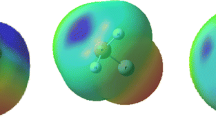Abstract
The positive electrostatic potentials (σ-hole) have been found in ylides CH2XH3 (X = P, As, Sb) and CH2YH2 (Y = S, Se, Te), on the outer surfaces of group VA and VIA atoms, approximately along the extensions of the C–X and C–Y bonds, respectively. These electrostatic potentials suggest that the above ylides can interact with nucleophiles to form weak, directional noncovalent interactions similar to halogen bonding interactions. MP2 calculations have confirmed the formation of CH2XH3···HM complexes (X = P, As, Sb; M = BeH, ZnH, MgH, Li, Na). The interaction energies, interaction distances, topological properties (electron density and its Laplacian), and energy properties (kinetic electron energy density and potential electron energy density) at the X(1)···H(10) bond critical points are all correlated with the most negative electrostatic potential value of HM, indicating that electrostatic interactions play an important role in these weak X···H interactions. Similar to the halogen bonding interactions, weak interactions involving ylides may be significant in several areas such as organic synthesis, crystal engineering, and design of new materials.










Similar content being viewed by others
References
Buckingham AD, Fowler PW, Hutson JM (1988) Chem Rev 88:963–988
Chałasiński G, Szczȩśniak MM (2000) Chem Rev 100:4227–4252
Wormer PES, van der Avoird A (2000) Chem Rev 100:4109–4144
Philp D, Stoddart JF (1996) Angew Chem Int Ed Engl 35:1154–1196
Klos J, Szczȩśniak MM, Chałasiński G (2004) Int Rev Phys Chem 23:541–571
Saalfrank RW, Maid H, Scheurer A (2008) Angew Chem Int Ed Engl 47:8794–8824
Llanes-Pallas A, Palma CA, Piot L et al. (2009) J Am Chem Soc 131:509–520
Clark T, Hennemann M, Murray JS et al. (2007) J Mol Model 13:291–296
Politzer P, Murray JS (2013) Chemphyschem 14:278–294
Politzer P, Murray JS, Clark T (2010) Phys Chem Chem Phys 12:7748–7757
Auffinger P, Hays FA, Westhof E et al. (2004) Proc Natl Acad Sci U S A 101:16789–16794
Politzer P, Lane P, Concha MC et al. (2007) J Mol Model 13:305–311
Murray JS, Lane P, Politzer P (2007) Int J Quantum Chem 107:2286–2292
Murray JS, Concha MC, Lane P et al. (2008) J Mol Model 14:699–704
Solimannejad M, Ramezani V, Trujillo C et al. (2012) J Phys Chem A 116:5199–5206
Murray JS, Lane P, Clark T et al. (2012) J Mol Model 18:541–548
Murray JS, Lane P, Politzer P (2009) J Mol Model 15:723–729
Clark T, Murray JS, Lane P et al. (2008) J Mol Model 14:689–697
Politzer P, Murray JS, Clark T (2013) Phys Chem Chem Phys 15:11178–11189
Murray JS, Politzer P (1998) J Mol Struct (THEOCHEM) 425:107–114
Politzer P, Murray JS (1999) Trends Chem Phys 7:157–165
Politzer P, Murray JS (2001) Fluid Phase Equilib 185:129–137
Hagelin H, Murray JS, Politzer P et al. (1995) Can J Chem 73:483–488
Zeng Y, Zhang X, Li X et al. (2011) Chemphyschem 12:1080–1087
Zeng Y, Zhu M, Li X et al. (2012) J Comput Chem 33:1321–1327
Johnson AW (1966) Ylid chemistry. Academic Press, New York
Scrocco E, Tomasi J (1973) The electrostatic molecular potential as a tool for the interpretation of molecular properties. Springer, Berlin
Politzer P, Daiker KC (1981) In: Deb BM (ed) The force concept in chemistry. Reinhold, New York
Politzer P, Laurence PR, Jayasuriya K (1985) Environ Health Perspect 61:191–202
Naray-Szabo G, Ferenczy GG (1995) Chem Rev 95:829–847
Murray JS, Politzer P (2011) WIREs Comput Mol Sci 1:153–163
Murray JS, Politzer P (2009) Croat Chem Acta 82:267–275
Politzer P, Murray JS (2002) Theor Chim Acta 108:134–142
Politzer P, Murray JS (1991) Reviews in computational chemistry. VCH, New York
Stewart RF (1979) Chem Phys Lett 65:335–342
Politzer P, Truhlar DG (1981) Chemical applications of atomic and molecular electrostatic potentials. Plenum, New York
Peterson KA, Figgen D, Goll E et al. (2003) J Chem Phys 119:11113
Boys SF, Bernardi F (1970) Mol Phys 19:553–566
Frisch MJ, Trucks GW, Schlegel HB et al. (2004) Gaussian 03. Revision D.01 ed. Gaussian, Inc., Wallingford
Bulat FA, Toro-Labbe A, Brinck T et al. (2010) J Mol Model 16:1679–1691
Bader RFW (1990) Atoms in molecules: A quantum theory. Oxford University Press, Oxford
Popelier PLA (2000) Atoms in molecules: an introduction. Pearson, Essex
Keith TA (2012) AIMALL. version 13.02.26 ed. USA
Murray JS, Lane P, Clark T et al. (2007) J Mol Model 13:1033–1038
Politzer P, Murray JS, Concha MC (2008) J Mol Model 14:659–665
Zeng Y, Li X, Zhang X et al. (2011) J Mol Model 17:2907–2918
Hobza P, Havlas Z (2000) Chem Rev 100:4253–4264
Lapointe SM, Farrag S, Bohorquez HJ et al. (2009) J Phys Chem B 113:10957–10964
Grabowski SJ (2011) Chem Rev 111:2597–2625
Zeng Y, Zhang X, Li X et al. (2010) Int J Quantum Chem 11:3725–3740
Cremer D, Kraka E (1984) Angew Chem Int Ed Engl 23:627–628
Bone RGA, Bader RFW (1996) J Phys Chem 100:10892–10911
Acknowledgments
Thanks for International Science Editing to edit this paper. This project was supported by the National Natural Science Foundation of China (Contract Nos.: 21371045, 21102033, 21171047, 21073051), the Natural Science Foundation of Hebei Province (Contract No.: B2011205058), and the Education Department Foundation of Hebei Province (ZH2012106, ZD2010126).
Author information
Authors and Affiliations
Corresponding authors
Rights and permissions
About this article
Cite this article
Ji, J., Zeng, Y., Zhang, X. et al. Discovery of σ-hole interactions involving ylides. J Mol Model 19, 4887–4895 (2013). https://doi.org/10.1007/s00894-013-1992-8
Received:
Accepted:
Published:
Issue Date:
DOI: https://doi.org/10.1007/s00894-013-1992-8




